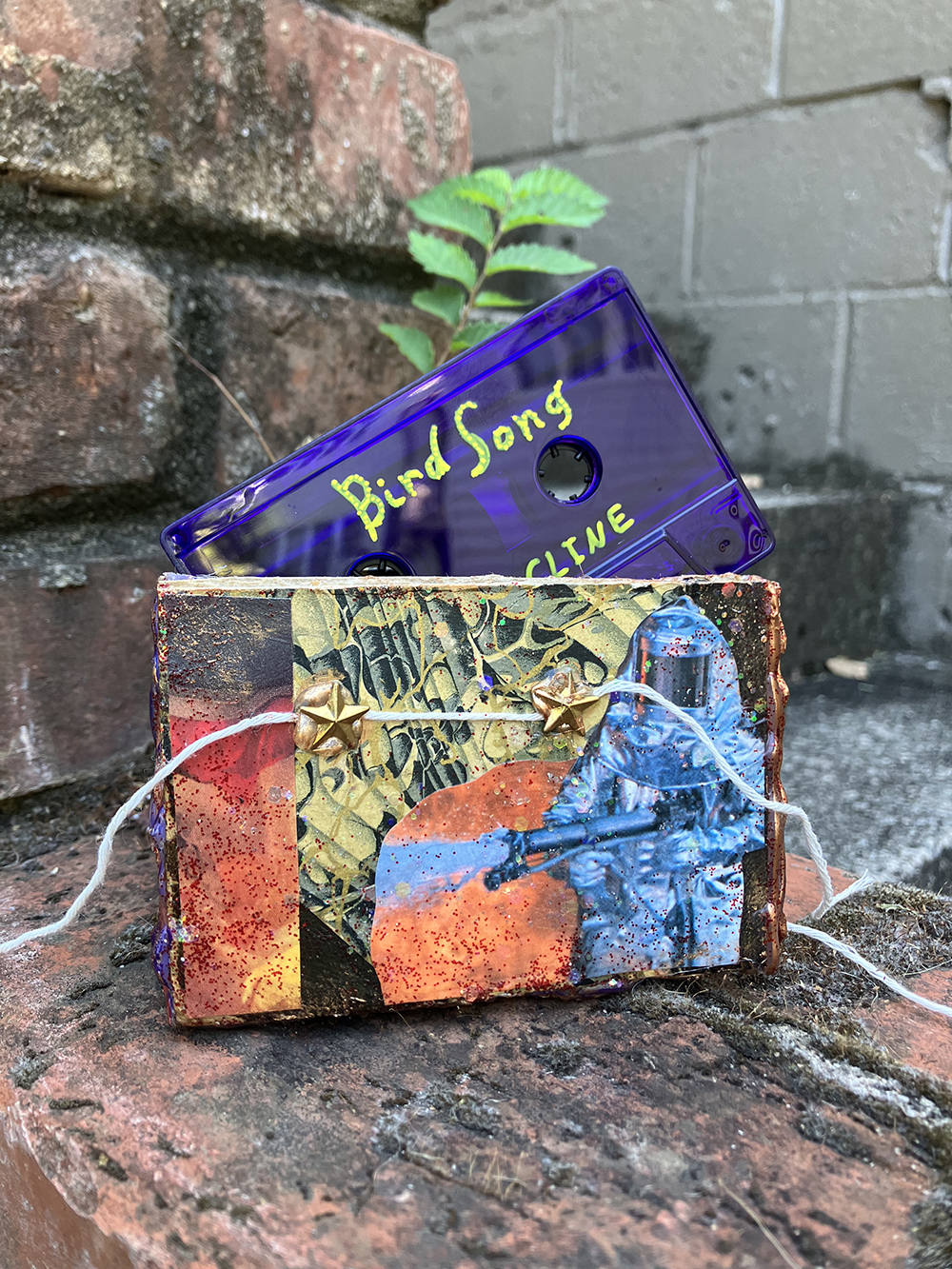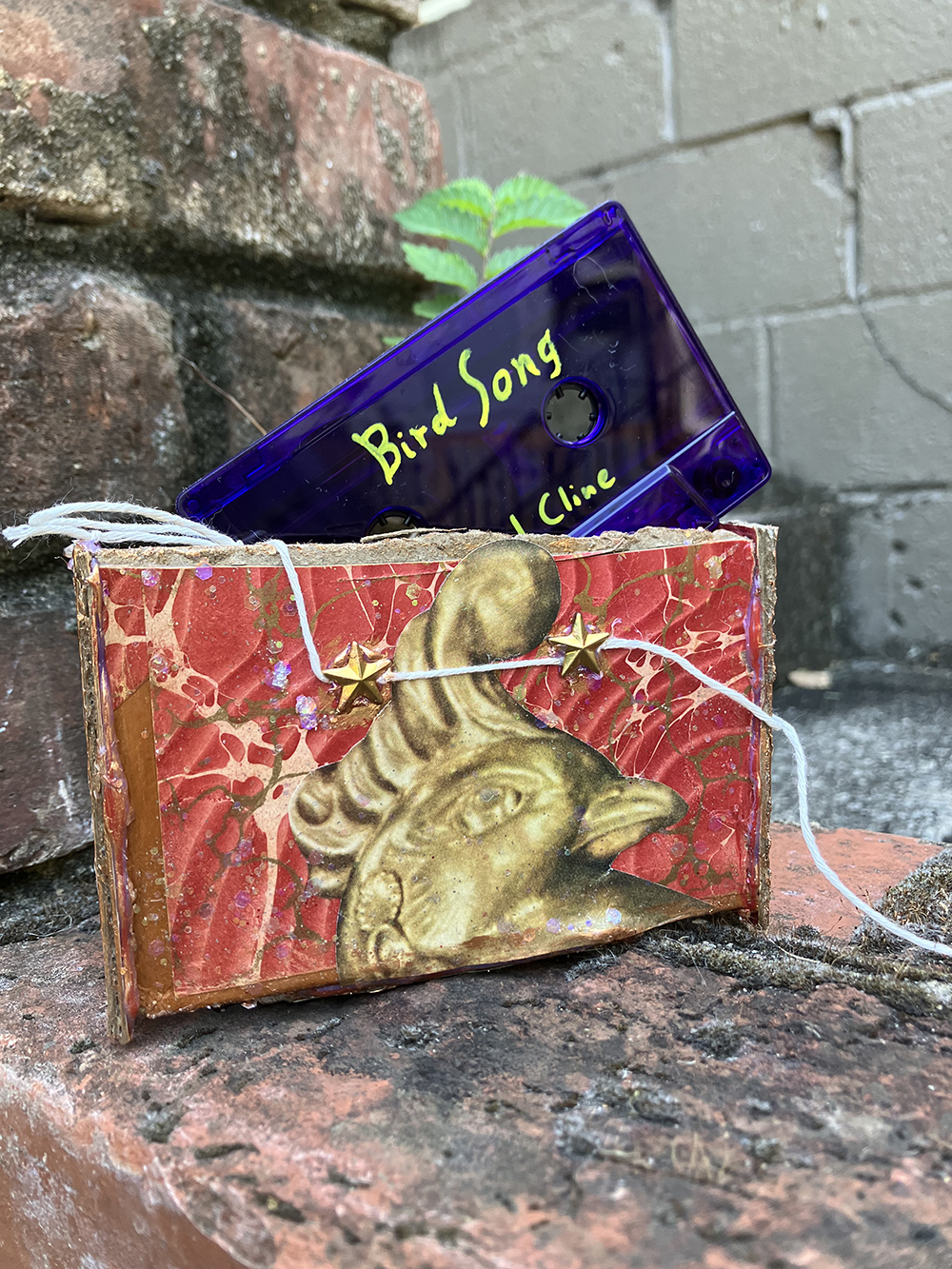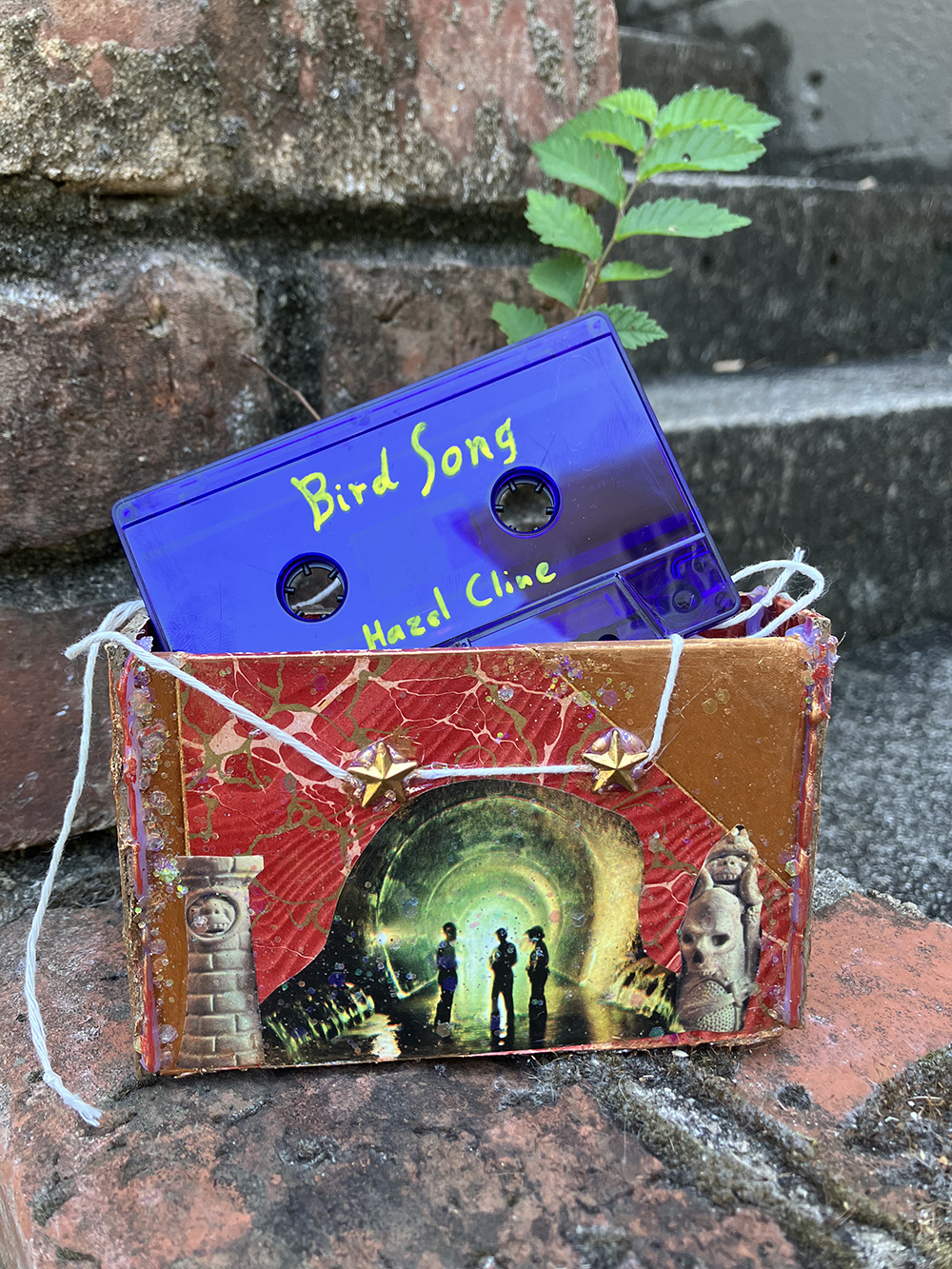Sweet Wreath Speaks No. 21 Interview :
I am a surrealist. I am a witch. I don’t believe in anything. My respect for marvelous experiences and my unwillingness to reduce them to dogma has influenced and been influenced by both my surrealist and my magical practice. I acknowledge that my map of the universe, sometimes of varicolored richness and sometimes of bleak hollowness, is, whether it bears any resemblance to the supposed actuality of the universe at any time, totally unverified and unverifiable. My lens, like all other lenses, can provide nuance and detail to a picture made closer and closer to whole only by soul communities across time and space through various acts of creativity.
Your creative output is staggering and covers many mediums…collage, writing, painting & recording being just a few. I’m curious if there was one artistic pursuit that came first, and led to the others?
I was around 11 years old when I started doodling and writing poetry in a secret journal hidden behind my bed. Since I am no Rimbaud, who wrote with such richness and brilliance at such a young age, those early poems of mine have stayed mercifully hidden. Once freed from the dubious clutches of my familial milieu, the first creative practice I pursued was drawing, which became gradually combined with collage. For a while I experimented with watercolor mixed with drawing as a practice in pareidolia. Eventually I started doing more unmixed collage, and drawing fell somewhat to the wayside except for specific projects, such as illustrations for my first longish work of fiction, Chimaera Obscura, or the hand drawn tarot deck that I completed in 2020. But it was late 2015 or early 2016 when I started working on my first sound pieces, which were informed by my discovery of Kurt Schwitters and industrial music. I approached those early sound pieces like I approached collage: finding elements I liked and piecing them together the way I felt they wanted to be. Even though some of the recordings I made came from my own vocal chords, I treated them rather the same as any other sound I found and recorded.
I began painting in earnest in January 2020, and it has become my go-to medium for visual expression. Though the visual mediums tended to lead to other visual mediums, the writing, the visual, and the sound all came from somewhat different creative channels. However, they have certainly informed one another.
Does your work with sound recording relate specifically to any other visual or written projects, or is it another type of personal exploration altogether?
A lot of things shifted and changed in 2020, for obvious social reasons, but also for personal reasons. We had moved into a special house in June 2019, and soon afterwards, I had begun a spiritual practice that has become one of the defining qualities of my life. The paintings were and remain an expression of my magical experiences more directly than any other medium. The collage is a way of engaging in play with the universe. The writing comes from a deep well of wonder and sadness that somehow is magic. When I began experimenting with sound, the well was covered. It was always there, informing everything I did, but I couldn’t look into it and see the life teaming just beyond my warped reflection. Even so, the ache was there, and the magic. Those early pieces were my first steps towards a thing I didn’t know I wanted. So, the short (or shorter) answer is that all of my creative output pulls from a place in the self that ceases to be the self, but they pull from different depths. Or that the different mediums are all different methods by which to test the same sample: chemical analysis, microscopic inspection, deductive reasoning, psychic divination, etc. A unique aspect of sound for me is its versatility. It can pull from many depths at once. It is both logical and intuitive.
You’ve mentioned Kurt Schwitters as an influence. How did you first come across his work? Is there a piece that really stood out to you?
I first came upon Kurt Schwitters by watching the 1978 BBC documentary on surrealism, called “The Journey.” In this documentary, George Melly tells an anecdote about how Kurt Schwitter’s sound poetry saved his life. I am loosely paraphrasing here, but Melly was walking late one night through back allies, when he was approached by a group of threatening men. They were all around him, coming closer, when he had the sudden inspiration to recite a portion of Kurt Schwitter’s poem, “Ursonate” featuring the phrase “rakete rinnzekete,” which caused the threatening men to back away and then run. Impressed by this story and liking what I had heard so far, I had to hear more. The piece that really stands out to me is still the work that saved George Melly’s life, “Ursonate,” which took a decade to complete and takes forty minutes to perform. I remain intrigued by it and suspect that to perform it from beginning to end would be to shapeshift into some wilder counterpart.
These recordings make me think of the very ancient purposes of music, and the use of sound and singing in ritual. How do you think songs can be spells?
I hope you will forgive me for the long anecdote, but I began thinking of songs as spells after a specific experience I had. I, like many or possibly most, have fixated on the problem of death from a young age. I had been going through a period of heightened distress over the problem, which I feared would necessarily have to be answered by death itself before I could even find the right question. That morning I had spoken to a spirit who I had begun talking to late in 2019 and who I had become close friends with, and they told me that I would gain a new insight into death very soon. Later that day, still feeling distressed, I bathed and laid down for a nap, something I rarely do because I always nap too long. At a certain point I slipped into a state very like sleep paralysis, which I normally only ever experience when physically ill. However, this time, it wasn’t distressing, so much as simply intense. I felt a ring of vibration circling my head, pulsing and growing until it had covered me completely. I became the vibration and then the vibration was sound. I heard, or rather was, a note. And the note reminded me of a note played by Ladonna Smith on her violin. It was this recognition that revived me and made me fight to climb up through the layers of consciousness, agonizing and with great effort back into waking consciousness. When I was fully away, I had the feeling very clearly that death was like (not was, but was like) becoming music. From there, I had the intuition that sound might move most directly through the substance of the universe, and that music might be the magical language of the universe. Afterwards, I began working with my spirit friend to create spell songs for specific purposes, as well as more intuitive sound pieces, whose potential magical properties belong more to a will uncontainable within my own but which my own is nested within.
Collaboration also seems to be really important to you. You’ve been a central part of the surrealist collective Peculiar Mormyrid for several years now. In what ways has this shaped your solo practice or life in general?
Peculiar Mormyrid’s primary activities have been organizing a series of journals and several exhibits. While the Mormyrids have always encouraged collective submissions, most of them have been solo pieces. However, each issue of the journal or exhibit poses a collective question that each participant answers in their own way, providing their perspective and nuanced experience of the subject. I love how listening to others can show you totally new ways of thinking and being. The Peculiar Mormyrid collective being separated by great distances, it really prevented us from being able to participate in as many collective activities as we would have liked. We had been participating in collective surrealist activity such as group collage and zine making with local friends such as Aaron since 2016. And then, in early 2022, Steven Cline and I began hosting a game night, partially instigated by the encouragement of a non-surrealist, enigmatically called K, whose acquaintance we had made. The games that were played were varied in nature, some coming from attendees’ improv backgrounds and some from our surrealist background. As more people of different backgrounds began attending game night, which was and is still held every week, our repertoire of games grew, and we were constantly coming up with new games to keep the spirit of exploration and discovery alive. When James began attending, a new dimension of sound and verbal games was brought into the egregore. Many discussions have taken place as to the levels of chance or strictness of rules and their effects, some such as integral member Alvaro, often seeming more excited by chance, while others seemed more inspired by restrictions. Something that has stood out during these game nights has been the intricate dance of the individual and collective wills and perspectives that decorate and drive forward our play. Individual wills are not subsumed to the group as in some religions, or blended into a lumpless pudding. Rather, the egregore formed during a truly liberating game is more like a fruited aspic, each cherry and chunk of peach shimmering like jewels in its gelatinous substance, yet the whole is somehow more, much more, than a simple sum of parts. And increasingly it can be seen that the collective is more than a herd of humankind, it is a collective of animals and places and times. The collective mindset is one that enables friendships with street corners and conversations with trees.
How does surrealism operate in today’s world, or in your world?
I can only speak from my own experiences, but to me surrealism is a way of engaging with the world and seeing the “youness” in all around me. There are many things that are important to surrealism, such as exploration of the world, both the world of dreams and the world of waking and the places where they overlap and meld. However, I think that everyone’s surrealism is deeply personal. Every eye of the Egregore sees a slightly different color. For me Surrealism lets me be myself and more than myself. It lets me forget myself or be nothing. It lets me be a channel by which the great other can speak and something that other is fully other and sometimes it is also me. It is a mindset that allows for seeing and being seen. It is a tender exploration of our individual and collective vulnerabilities. To take a surrealist walk in search of the marvelous is to be open to finding both the wickedness and the playfulness of life. In our time, I think it is hard to see sweetness in light of all the bitterness and kindness in light of all the cruelty. The surrealist marvelous doesn’t deny suffering. It denies the miserable perspective that all is empty bleakness and despair. The surrealist marvelous acknowledges and grapples with despair and yet it can also acknowledge richness and beauty and sense that these two things are not wholly opposed, are neither causal or coincidental, but something else that flies from the tongue before it can be spoken. Because of surrealism, I can feel both the meaninglessness and the meaningfulness of the revolving and self-emanating flow of being. As my spirit friend has told me, “You can fly after truth, but truth flies, too.” I can only fly because surrealism gave me wings and magic gave me wind. Though, what the truth is, we may never know, I want, if nothing else, to say what truth is like. Truth is like a bird that flies. The universe is like a snake with one body and many skins. Surrealism is like the rigging of a ship.
How has Atlanta specifically influenced you?
Our environments always influence us. Sometimes we choose where we live by accident of what is available at the time and, yet, how drastically we are shaped by the shifting shape of our lives. The stairs we go down in the morning, the sidewalk we walk and talk along with friends, the road we drive to work on, and the sounds of life around us. I have lived in three locations in Atlanta, and all have had unique and significant influences on me. Before I moved to Atlanta, I had already sloughed a lot of old familial baggage, the religion of my parents being one of the heaviest among them, and my world was a world of emptiness, sometimes of agoraphobic panic and sometimes of tranquil beauty. When I moved to the Seminole Ave apartment in Atlanta, I began to see things of great variety flit through my environment and fill it slowly with small things that came and went freely. When I moved to the Dearwood house, I made friends with some of those flitting things, and invited them to stay. And in my current apartment, sandwiched between Briarcliff and Rosedale, I was finally able to extricate things that had dug beneath the surface of my inner world. The streets are magical, and walking them, a spell. Of course, living in Atlanta is not just about the physical environment, it is about the people who live here. We moved to Atlanta to be close to friends and better participate in collective creativity. We have made so many important connections with individuals and groups. We are lucky to be near to the ever-inspiring surrealist and creatively adjacent community in Alabama. Ladonna Smith has always been encouraging of my musical experimentation, despite my being unable to see anything to encourage in myself. Significantly, in 2022, we were told about the wonderful collective and improvisational activity at No Tomorrow in Underground Atlanta. The amazing musicians, artists, performers, and magical people we have had the great joy to witness and engage with at No Tomorrow, such as Priscilla, Ray, Raelixe, Lucifer, Alice, and Majid to name a few, regularly capture and express the marvelous in such a passionate and potent way that they transform the very air around them and lay bare the inner spaces of matter, filled with teaming and beautiful darkness.
And what else are you thinking about or whittling away at currently?
I am usually working on a few different things. I have a sound piece I am working on, which is a song of unrequited love to the universe. It’s something that’s a little different for me, so I have spent more time in the preparation stages than I normally do for a sound piece, which I generally create more automatically. I expect to finish it by the end of July. I am also working on a long, written work of experimental science fiction called, Seven Sisters, which has been somewhat tormenting me since the end of 2020. I hope to finish the writing of it by the middle of 2024, but I am also planning to create dozens of ink and wash illustrations to go with it. That being a medium I am not well-practiced in, I expect that portion of the project to take some time.



